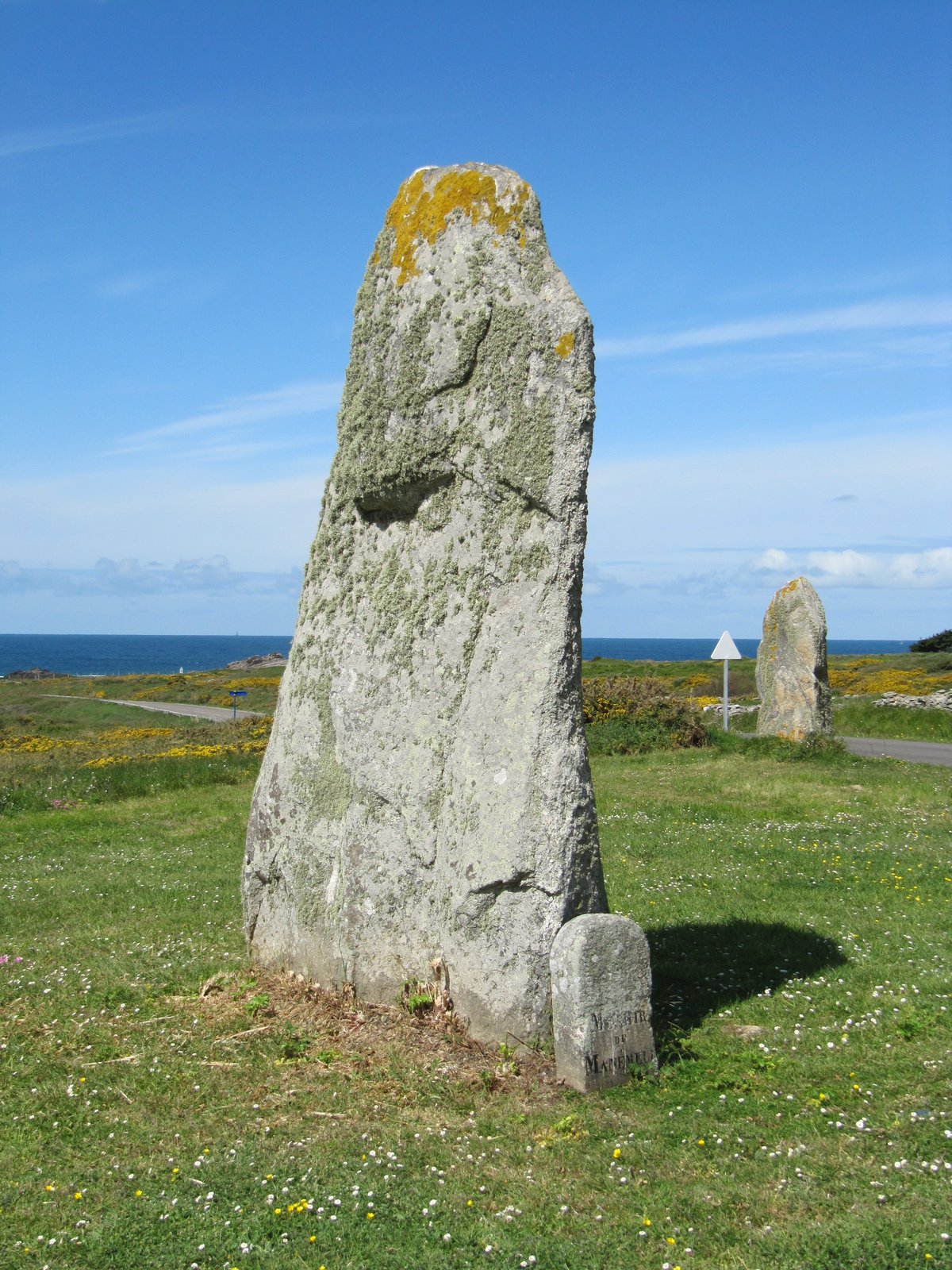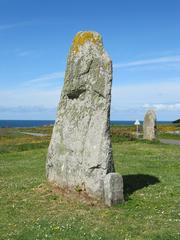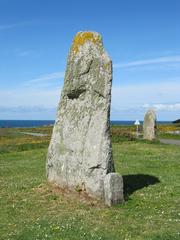
Menhirs de Mané-Meur: Visiting Hours, Tickets, and Guide to Quiberon Historical Sites
Date: 14/06/2025
Introduction: Discover Brittany’s Prehistoric Marvel
Nestled on the windswept Quiberon Peninsula in Brittany, France, the Menhirs de Mané-Meur are some of Europe’s most evocative Neolithic monuments. Erected between 4500 and 2000 BCE, these ancient standing stones offer a captivating window into the ingenuity and spiritual lives of early agricultural societies. Their enduring presence has shaped Brittany’s identity, inspired local folklore, and continues to intrigue travelers, archaeologists, and cultural enthusiasts alike.
Standing prominently atop “Mané-Meur”—meaning “Great Hill” in Breton—the three menhirs overlook open heathlands and the Atlantic, symbolizing both territorial command and ritual significance. Their unique arrangement, with Menhir No. 1 reaching 3.40 meters and marked with mysterious cupules, and Menhirs No. 2 and 3 forming a suggestive alignment, makes this site a distinctive element of Brittany’s celebrated megalithic landscape, alongside sites such as the famed Carnac alignments (France Today, POP: Plateforme ouverte du patrimoine, Musée du Patrimoine).
Quick Guide: Contents
- Introduction & Historical Context
- Neolithic Construction and Symbolism
- Archaeological Insights
- Cultural and Mythological Background
- Practical Visiting Information
- Hours & Admission
- Accessibility
- Getting There
- Guided Tours
- Nearby Attractions
- Conservation & Responsible Tourism
- FAQs
- Summary & Visitor Tips
- Sources & Further Information
The Neolithic Legacy: Construction and Significance
The Menhirs de Mané-Meur are iconic representatives of the Neolithic transition in Western Europe, when communities shifted from nomadism to settled farming and monumental construction (France Today). The term “menhir” itself derives from Breton—“men” (stone) and “hir” (long)—aptly describing these upright stones.
- Menhir No. 1: The most prominent, standing 3.40 meters high and adorned with sixteen enigmatic cupules.
- [Menhirs No. 2 and 3: Located approximately 250 meters to the west, possibly the remnants of a larger ceremonial alignment (Wikiwand).](#menhirs-no.-2-and-3:-located-approximately-250-meters-to-the-west,-possibly-the-remnants-of-a-larger-ceremonial-alignment-(wikiwand).)
Their construction required sophisticated organization and communal effort, reflecting both technical prowess and strong social bonds. The stones’ placement on an elevated vantage point suggests roles as territorial markers, ceremonial sites, or even astronomical observatories (BBC Travel, Ancient Pages).
Archaeological and Cultural Context
Brittany is renowned for its dense concentration of megalithic monuments—over 3,000 in Morbihan alone. While the Carnac alignments are world-famous, the Menhirs de Mané-Meur offer a more intimate encounter with Neolithic culture. Recent excavations have revealed the presence of dolmens and cairns nearby, deepening our understanding of the site’s complexity (Musée du Patrimoine, Wikiwand).
Local folklore further enlivens the stones—legends abound of giants, korrigans, and magical happenings. These stories, passed through generations, entwine the menhirs with Brittany’s living cultural landscape (Bretagne Côte de Granit Rose).
Practical Visiting Information
Hours & Admission
- Open access year-round. The menhirs are in open, unfenced spaces, accessible 24/7. Daylight visits are recommended for both safety and optimal appreciation.
- Admission: Free. No tickets required.
Accessibility
- The site is outdoors on uneven, grassy terrain. There are no paved paths or formal accessibility features. Sturdy footwear is advised, and those with mobility concerns should plan accordingly.
Getting There
- By car: Follow the D768; parking is available near Manémeur village.
- By bicycle: The peninsula has well-marked cycling routes (Baie de Quiberon).
- By public transport: Regional buses serve Quiberon town, from which the stones can be reached on foot or by bike.
On-site Facilities
- There are no restrooms, cafés, or shelters at the site. The nearest amenities are in Quiberon town (2 km).
- For in-depth context, visit the Maison du Patrimoine in Quiberon (Ville de Quiberon).
Guided Tours & Events
While regular tours are not scheduled, local tourism offices sometimes organize heritage walks, especially during events like the European Heritage Days (Monumentum). Digital resources and guidebooks are recommended for self-guided exploration.
Nearby Attractions
- Dolmen du Conguel: Passage grave at the peninsula’s tip.
- Tumulus de Beg-en-Aud: Ancient burial mound.
- Côte Sauvage: Dramatic Atlantic coastline walks.
- Musée de la Préhistoire (Carnac): Extensive megalithic exhibits.
Responsible Tourism & Conservation
The Menhirs de Mané-Meur are protected as monuments historiques (Menhir No. 1 since 1889; No. 2 and 3 since 1927/1931), and form part of a broader UNESCO World Heritage proposal (Ville de Quiberon). Visitors are urged to:
- Respect the site: Do not climb or deface the stones.
- Stay on paths: Protect both heritage and surrounding flora.
- Support local initiatives: Engage with heritage days, workshops, and guided walks.
FAQs
Q: Are tickets required to visit the Menhirs de Mané-Meur?
A: No, the site is open and free to the public year-round.
Q: What are the visiting hours?
A: The site is accessible 24/7; daylight visits are recommended.
Q: Is the site accessible for visitors with limited mobility?
A: The terrain is uneven and unpaved; accessibility is limited.
Q: Are guided tours available?
A: Occasional tours are offered by local organizations during special events. Inquire at the Quiberon Tourist Office.
Q: Where can I find more information or maps?
A: The Quiberon Tourist Office and official town website offer maps and visitor details.
Summary & Visitor Tips
- Free, open access year-round; best visited in daylight.
- Wear suitable footwear for uneven terrain.
- Combine your visit with other megalithic and coastal sites on the Quiberon Peninsula.
- Respect the stones and environment—these are irreplaceable monuments.
- Consult digital guides and local museums for enriching context.
- Spring and autumn offer the most pleasant conditions and fewer crowds.
For up-to-date information, consult the Quiberon Tourist Office, and consider using the Audiala app for digital guides and audio tours.
Sources & Further Information
- France Today
- POP: Plateforme ouverte du patrimoine
- Musée du Patrimoine
- Ville de Quiberon
- Monumentum
- BBC Travel
- Ancient Pages
- Bretagne Côte de Granit Rose
- Wikiwand
For the best experience, supplement your visit with high-quality images and interactive maps available online. Download the Audiala app for further guides and follow us on social media for the latest heritage updates.


